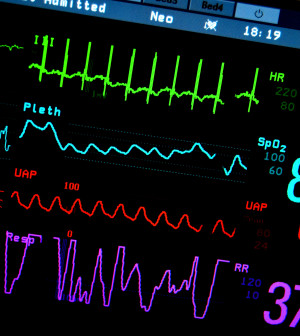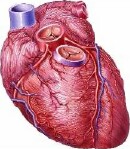- Double Mastectomy May Offer No Survival Benefit to Women With Breast Cancer
- Toxic Lead Found in Cinnamon Product, FDA Says
- Certain Abbott Blood Sugar Monitors May Give Incorrect Readings
- Athletes Can Expect High Ozone, Pollen Counts for Paris Olympics
- Fake Oxycontin Pills Widespread and Potentially Deadly: Report
- Shingles Vaccine Could Lower Dementia Risk
- Your Odds for Accidental Gun Death Rise Greatly in Certain States
- Kids From Poorer Families Less Likely to Survive Cancer
- Tough Workouts Won’t Trigger Cardiac Arrest in Folks With Long QT Syndrome
- At-Home Colon Cancer Test Can Save Lives
Injected Gel Might Someday Help Treat Heart Failure


Attempting to reduce the risk for heart failure following a heart attack, early research on swine takes a new protective approach: targeted injection of naturally occurring “protein inhibitors” directly into the heart.
The invasive procedure has only been attempted on adult pigs, whose hearts are considered comparable to that of humans.
But preliminary success in staving off heart failure in animal research already amounts to a “proof of concept,” the investigators said, demonstrating that such a technique could work in people, too. And maybe even improve upon current oral medications.
Study co-author Dr. Francis Spinale, director of the Cardiovascular Translational Research Center at the University of South Carolina School of Medicine, described how heart attacks can lead to heart failure in humans.
“The heart is composed of four chambers, with the one that pumps oxygenated blood to the body termed the left ventricle,” Spinale said. “[And] a change in the shape of the left ventricle is one of the key factors that physicians measure in patients following a heart attack.”
The stress of a heart attack typically sends problematic tissue-destroying enzymes — known as “MMPs” — into overdrive, while at the same time blocking the activity of the body’s helpful enzymes, known as “TIMPs,” Spinale explained.
The result: a swelling of the left ventricle from football shape to basketball shape, followed by structural collapse, he said. This ultimately leads to heart failure, in which the heart loses the ability to pump sufficient blood throughout the body.
This worst-case scenario, Spinale said, is the drive behind his team’s research: “to develop a strategy to restore the balance between MMPs and TIMPs in hopes of stopping this left ventricle remodeling process after a heart attack.”
Spinale, who’s also with Dorn Veteran Affairs Medical Center in Columbia, S.C., and colleagues published their findings in the Feb. 12 issue of Science Translational Medicine.
To reign in MMP activity, the investigators first combined a gelatin-type recipe containing hyaluronic acid with a slow-releasing compound of a specific TIMP called “TIMP-3.”
Then, over a two-week period, the hearts of pigs that had been induced to have a heart attack were injected with either the TIMP-3/hydrogel mix or a non-medicinal saline solution.
In the weeks following a TIMP-3/hydrogel injection, the pigs that received it were found to have improved heart function, sidestepping the dangerous breakdown and reshaping of the heart’s left ventricle.
The study team suggests that the new approach is a hopeful bet for human patients, given the similarity of pig and human heart anatomy, and previous indications that hydrogels can be safely injected into the human heart.
Experts note, however, that research with animals often fails to provide similar results in humans.
Dr. Nieca Goldberg, an American Heart Association spokeswoman, said it remains to be seen just how effective the new hydrogel treatment will prove to be in human patients.
“It’s very important to talk about the fact that this is an animal study, which means that it’s not yet ready for prime time. But certainly this is promising research,” said Goldberg, medical director of the women’s heart program at NYU Langone Medical Center, in New York City.
“We’re always looking for ways that we can avoid damage to the heart muscle after a heart attack,” she said. “Right now we use [medications such as] ACE inhibitors and beta blockers to prevent heart failure. Before those came on board as options, more people had heart failure as a result of their heart attacks than is the case today.
“So this approach should be seen as another idea, an interesting therapy for the future, that may help us continue to bring heart failure risk further under control,” Goldberg said.
More information
To learn more about heart failure, visit the American Heart Association.
Source: HealthDay
Copyright © 2024 HealthDay. All rights reserved.










